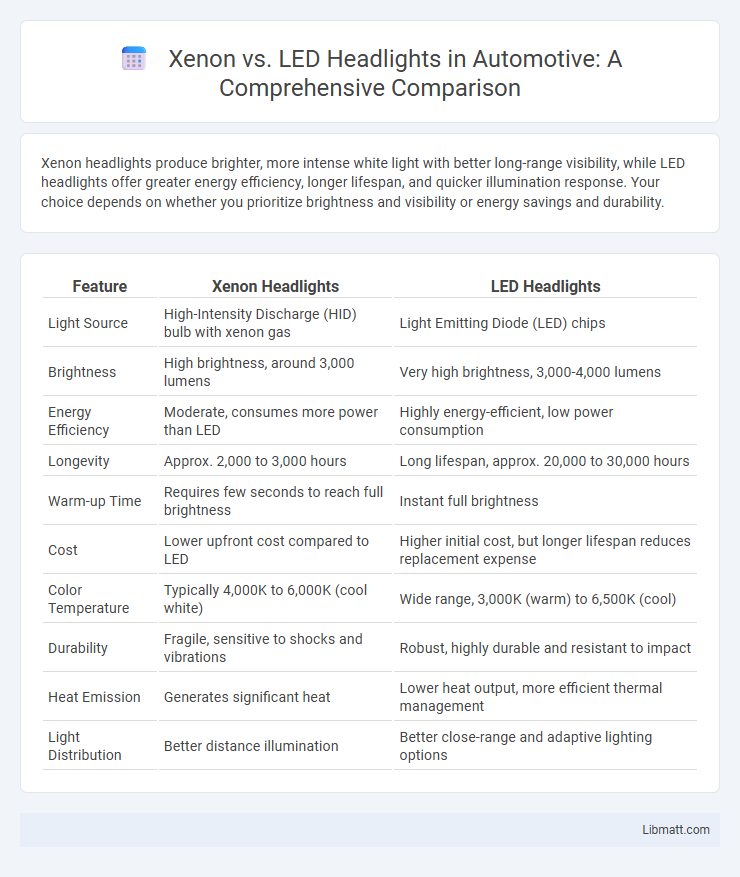Xenon headlights produce brighter, more intense white light with better long-range visibility, while LED headlights offer greater energy efficiency, longer lifespan, and quicker illumination response. Your choice depends on whether you prioritize brightness and visibility or energy savings and durability.
Table of Comparison
| Feature | Xenon Headlights | LED Headlights |
|---|---|---|
| Light Source | High-Intensity Discharge (HID) bulb with xenon gas | Light Emitting Diode (LED) chips |
| Brightness | High brightness, around 3,000 lumens | Very high brightness, 3,000-4,000 lumens |
| Energy Efficiency | Moderate, consumes more power than LED | Highly energy-efficient, low power consumption |
| Longevity | Approx. 2,000 to 3,000 hours | Long lifespan, approx. 20,000 to 30,000 hours |
| Warm-up Time | Requires few seconds to reach full brightness | Instant full brightness |
| Cost | Lower upfront cost compared to LED | Higher initial cost, but longer lifespan reduces replacement expense |
| Color Temperature | Typically 4,000K to 6,000K (cool white) | Wide range, 3,000K (warm) to 6,500K (cool) |
| Durability | Fragile, sensitive to shocks and vibrations | Robust, highly durable and resistant to impact |
| Heat Emission | Generates significant heat | Lower heat output, more efficient thermal management |
| Light Distribution | Better distance illumination | Better close-range and adaptive lighting options |
Introduction to Xenon and LED Headlights
Xenon headlights utilize high-intensity discharge (HID) technology, producing bright, white-blue light through an electric arc between tungsten electrodes inside a xenon gas-filled bulb. LED headlights rely on light-emitting diode technology, converting electricity directly into light with high energy efficiency and longer lifespan. Both technologies offer superior brightness and visibility compared to traditional halogen bulbs, but differ significantly in energy consumption, durability, and color temperature.
How Xenon Headlights Work
Xenon headlights operate using high-intensity discharge (HID) technology, where an electrical arc passes between two tungsten electrodes enclosed in a filled tube of xenon gas, producing a bright, white-blue light. The gas ionizes when voltage is applied, creating a powerful and efficient light source that outshines traditional halogen bulbs. This process results in better illumination range and clarity, enhancing nighttime visibility and safety.
How LED Headlights Work
LED headlights generate light by passing an electrical current through semiconductor diodes, producing a bright and energy-efficient beam. These diodes emit focused, instant illumination with high color accuracy, enhancing visibility while consuming less power compared to xenon bulbs. Your vehicle benefits from longer-lasting LED headlights that maintain consistent brightness without the warm-up time required by xenon lights.
Brightness and Light Quality Comparison
Xenon headlights produce a brighter, more intense light with a color temperature typically around 4,300K, closely mimicking natural daylight, which enhances visibility and reduces eye strain while driving at night. LED headlights offer sharper, more focused beams with higher energy efficiency and longer lifespan, emitting a cooler, whiter light often between 5,000K and 6,500K, providing clearer contrast for better object recognition. Your choice between Xenon and LED headlights should consider the preferred brightness level and light quality that best suits your driving conditions and visibility needs.
Energy Efficiency: Xenon vs LED
LED headlights outperform Xenon lights in energy efficiency by consuming up to 30% less power while delivering comparable brightness and visibility. Xenon headlights generate more heat and require a ballast, increasing overall energy use and reducing system lifespan. For maximizing your vehicle's energy efficiency and prolonging headlight longevity, LED technology is the superior choice.
Lifespan and Durability of Each Technology
Xenon headlights typically have a lifespan of around 2,000 to 3,000 hours, while LED headlights can last up to 30,000 to 50,000 hours due to their solid-state design. LEDs are more durable as they are less susceptible to shock and vibration compared to fragile xenon gas bulbs. The extended lifespan and resilience of LED headlights reduce the frequency of replacements and maintenance costs, making them a more cost-effective choice over time.
Installation and Maintenance Considerations
Xenon headlights require specialized ballasts and precise alignment during installation to ensure optimal performance, often necessitating professional expertise. LED headlights are generally easier to install, offering plug-and-play options compatible with most vehicle systems and requiring minimal maintenance due to their longer lifespan and durable design. Choosing LED headlights can reduce your maintenance needs and simplify the upgrade process compared to the more complex servicing Xenon systems demand.
Cost Differences Between Xenon and LED Headlights
Xenon headlights typically cost between $300 and $600 per unit, while LED headlights range from $250 to $500, making LEDs generally more affordable upfront. Maintenance and replacement costs for xenon bulbs are higher due to their shorter lifespan of about 2,000 hours compared to LEDs, which can last up to 30,000 hours or more. Although initial costs vary, LED headlights offer better long-term value through energy efficiency and lower replacement frequency.
Safety and Visibility: Real-World Performance
Xenon headlights deliver brighter, whiter light with greater intensity, enhancing visibility and allowing drivers to detect obstacles and road signs more clearly at night. LED headlights offer quicker illumination response and more focused beam patterns, reducing glare and improving contrast, which contributes to improved safety in various driving conditions. Real-world performance studies indicate both technologies provide superior visibility compared to halogen lamps, but LED headlights are often favored for their energy efficiency and longer lifespan.
Which Is Better: Xenon or LED Headlights?
Xenon headlights produce a brighter, more intense light with superior penetration, enhancing visibility in adverse weather conditions, while LED headlights offer longer lifespan, greater energy efficiency, and faster illumination. LED technology allows for more compact and versatile designs, improving aesthetics and aerodynamics compared to the bulkier Xenon bulbs. Overall, LED headlights are generally considered better due to their durability, lower power consumption, and increasingly comparable brightness and color temperature to Xenon lights.
xenon vs LED headlights Infographic

 libmatt.com
libmatt.com